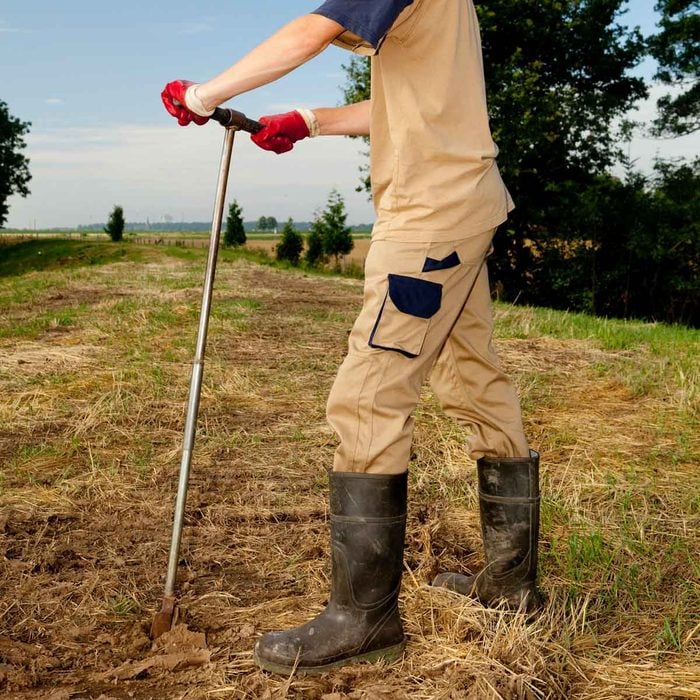What Is a Perc Test?
Updated: Mar. 13, 2024

If you’re building in a rural area without a municipal sewage system, you’ll likely need this test. Learn all about percolation tests and how they relate to septic systems.
Home builders need to complete many soil tests before building on a new plot of land. One of the most common tests is a percolation (perc) test. Percolation tests provide necessary information about the ground you’re building on, and they’re even required by some municipalities. So what is a perc test? Here, we’ll discuss the details.
On This Page
What Is a Percolation Test?
A perc test is a soil test that measures water absorption. “The tests are required in order to properly design an adequate septic system for the building being planned,” says Ray Brosnan of Brosnan Property Solutions.
The test is pretty simple: It’s done by “digging a hole in the soil of the proposed field, presoaking the holes and then filling the holes to a predetermined, measurable level,” says Brosnan. Experts then measure the amount of time it takes for the water to absorb into the soil.
A professional perc test may involve multiple holes, different-sized holes, holes with gravel and other variations. Each jurisdiction has its own laws on perc tests.
Why Are Perc Tests Conducted?
Before installing a septic system, you must determine the percolation rate of the surrounding land. Otherwise, your septic system could flood or pollute groundwater.
“Septic systems require a minimum and maximum percolation rate,” says Volodymyr Barabakh, co-founder and project director of BM International Builders. “This rate is usually around 60 minutes per inch as a minimum and 150 minutes per square inch maximum.” This means that the water dropped one inch in 60 minutes, or one inch in 150 minutes.
If a perc test determines your soil is unable to handle liquids within the required percolation range, it is unsafe to install a septic system, and you won’t get approval from the health department. There are a few other options, which we’ll discuss later.
While septic systems are the most common reason for perc tests, the test is also useful in measuring flood risk. “In areas where there will be a large amount of water deposited onto the land, either by nature or by design,” says Barabakh, “we need to know how efficiently that land can absorb the water to understand potential flood risks.”
How Are the Results Measured?
The percolation rate is measured by volume and time, often in cubic inches per minute. This tells you the permeability of the ground. As you might expect, sandy soils tend to be more permeable, while heavy clay soils tend to be less permeable.
Most often, when a building site fails a perc test, it’s because the ground isn’t permeable enough. That means the septic system’s drainfield will drain too slowly. “If soil is too permeable,” says Barabakh, “this poses a pollution risk as effluence from the septic tank can be absorbed into the groundwater.” This is much more rare.
How Much Does a Perc Test Cost? Plus Additional Considerations
Perc testing typically costs between $750 and $1,850, according to HomeAdvisor. However, that is just one portion of the testing cost. You may need to conduct additional tests before building, such as a deep hole test or a seasonal high water table test, which will add to the total soil testing cost.
Deep hole testing is used to analyze drainage in the soil surrounding a proposed septic drainfield. “It is done by digging a hole around six to nine feet deep and extracting soil at various depths,” Barabakh says. “This gives you an overview of the layers of soil that will surround a septic system.” Brosnan says deep hole tests “are used when looking to install a horizontal seepage pit or a leach line system.”
A seasonal high water table test shows the depth of the water table around the proposed septic system. The water table and slope of the land are considered when locating drainfields and wells, according to the United States Geological Survey’s “Ground Water and the Rural Homeowner.”
What Happens if You Fail a Perc Test?
What happens after a failed perc test depends on your location. “A failed perc test could mean you’ll be unable to build,” says Brosnan. “In rural areas without municipal sewage systems, you could be out of luck.” However, soil with a low percolation rate has more options than land that is too permeable.
“If soil has too low a percolation rate, you will need to find some other way of transporting excess water away from the property,” says Barabakh. Those include “creating a dam or trench, or through installing additional piping systems,” he says. This can be expensive and may push a project out of your building budget.
You can also consider alternative systems. Some off-grid methods of waste water management eliminate the need for a traditional septic system. Speaking with local authorities is the best way to determine a path forward after a failed perc test. They will help you decide which options are most viable in your area.